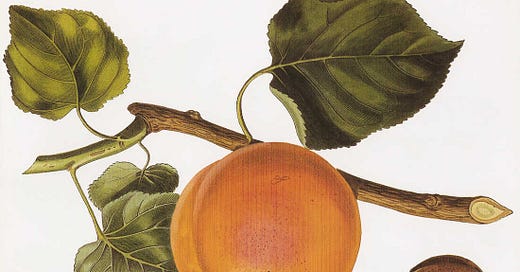If you're reading this, it's safe to assume that you have either seen or consumed an apricot sometime in your life. If not, visit a marketplace near you and acquaint yourself to the sweet yet tarty flavour of this montane fruit.
This is the story of the apricot and how its nomenclature yields clues to its Turkic heritage in India. Journeying from Zardaloo (Persian) to Chuli (Ladakhi) to Qubani (Urdu), the fruit has traveled a long way though experience of savouring the fruit still remains the same.
The Apricot in India
Going back to 3000 BCE, apricots have traveled a long way through time and geography beginning in China and then traveling through the Silk Route, eventually reaching Europe. Did it take root in India then? Perhaps but I could not find any mentions of it. It did however travel along the Himalayan passes, journeying via Ladakh and deep into Central Asia with the Arab traders. It is perhaps here that the name Chuli for it was coined though it’s difficult to verify.
The Ladakhi Chuli Chhu is consumed by soaking apricots in water overnight and eating the softened fruit the next day, with the water absorbing some of the flavours.
The Arabs had various names for it depending on the context. F'il mish-mish or simply mishmish or mishmishya is a colloquial name for apricot while Al-Barqouq is a more formal term for it. Citing Andrea Riordan verbatim fom her article in Edible Communities, the link to the original article can be found in the citations for this article.
’il mish-mish is an Arabic saying whose English equivalent is “When pigs fly” or “In your dreams,” meaning that something will never happen. Mish-mish is the colloquial word for apricot; the formal Arabic word is al-barqouq. Literally translated, f’il mish-mish means “in the time of the apricots” or “when the apricots bloom.” The only time I ever used it was when I was in my early twenties and had a particularly ardent admirer while staying in the Sinai Peninsula with my sister. It was as if I’d said, “In your dreams, buddy!” He got the message.
Qamar Al Din ("moon of the faith") is a drink made from apricots, its juice dissolved in rosewater or orange blossom and served chilled to the faithful at the time of breaking the Roza or day-long fast during the month of Ramadan.. From Qamar Al Din came Amardine or fruit leather. Soon enough Amardine became an integral part of the Arabian world.
Traveling eastward toward Persia, the Persians called it zardaloo or yellow plum, alu or aloo being the word for plum. The word zardaloo is most commonly used across India to refer to the apricot, Marathi using it verbatim from Persian (Farsi). At this point, I must introduce you to one more word, Khurmani or Khubani.
From Zardaloo to Khurmani/Khubani
The kh (similar to the Germanic word ich) sound in Khumani and Khubani is a voiced aspirate, meaning the word is pronounced breathily. The same holds true for words in Urdu such as Khan, Khala, Khatun, Khatam etc. The sound is not native to India and in parts of the country, especially South India, the word khana khaaya (did you have your food?) becomes kana kaya, much to the mirth of Hindi and Urdu speakers.
The kh (ख़)in question comes from Turkic languages including Uzbekistan. The Turkic people spanned a huge geographic swathe of territory and their culture and mannerisms traveled along the Silk Route with them.
Beginning with Mahmud of Ghazni from the 10th century C.E., Turki or Turkic people invaded India, set up Islamic Sultanates with varying degrees of success across the country. While empires were rising and falling at the time, there were also itinerant travelers, scholars, mercenaries from the Turkic and the larger Perso-Arab world who sought fame, fortune and succour in India. With their arrival came the Persian as an elite court language and various languages and dialects developed across peninsular India.
A language spoken by an elite group seldom trickles down into the local populace intact. Indeed such a deed would be blasphemous and there cannot be a safe separation between the gentry and the great unwashed.
From the time of the Sanskrit speaking Vedic people to the Persian speaking elite in Mughal and Dakhani courts, the core language was spoken only within elite circles. For everyday transaction and communication, there developed languages that imbibed Sanskrit and Persian, Prakrit and Hindavi respectively among other dialects.
Starting as a form of Persianized Hindi in the year 1700 in Hyderabad, Jafar Zatalli started a new tradition when he began composing ghazals in this language which would one day become Urdu. The word Urdu itself comes from the Turkic word Ordu, meaning army which incidentally helped coin the English word Horde. The Golden Horde is a moniker for a Mongol Khanate that spread westward, reaching the boundaries of Europe in the 13th century and the word Mughal is Persian for Mongol.

The apricot dessert traveled with the Turkic people who introduced it to the Indian cuisine library. And so we arrived at Khurmani or Khubani ka meetha. The recipe remains more or less the same as Chuli Chhu except that the apricots are boiled with sugar and deseeded, the nuts from the seeds later served as garnish in the boiled apricot mix. Today’s Khubani ka meetha is served with a dollop of vanilla ice cream, which I have tasted in Bidar and Hyderabad, incidentally the reason why I am writing this article.
From Khubani to Qubani
There have been several corrections to the original hypothesis that a separate article had to be published: Khubani ka Meetha: Some important corrections
Citations, refererences and suggested reading:






Very well researched and interesting read!